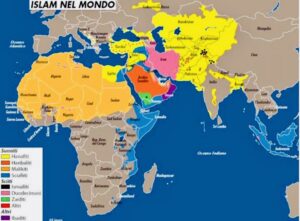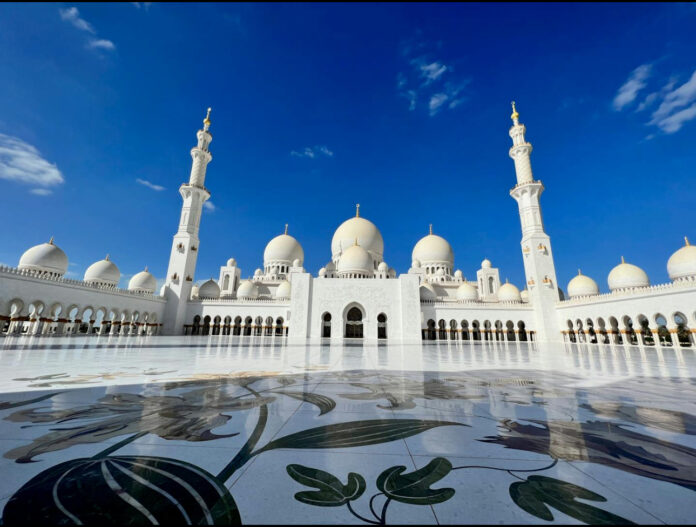Più del 23% della popolazione mondiale è musulmana, rendendo l’Islam la seconda religione più grande a livello globale, dopo il Cristianesimo. Attualmente, l’Indonesia ha il maggior numero di musulmani; l’Islam è anche diffuso in Asia meridionale, Medio Oriente e Africa subsahariana. Molti musulmani risiedono anche in Europa, Cina, Stati Uniti e Russia.
Il Corano è il testo sacro centrale, e Maometto è considerato l’ultimo profeta (seguendo Gesù, che è anche venerato come profeta nell’Islam).
Per i musulmani, la moschea serve sia come luogo di preghiera che come spazio di incontro comunitario. Le moschee non contengono raffigurazioni di esseri umani o animali; invece, la geometria caratterizza i loro spazi. Infatti, gli architetti musulmani svilupparono conoscenze matematiche molto prima dei loro omologhi occidentali, grazie alla stretta relazione tra geometria e teologia.
Come l’ebraismo e il cristianesimo, l’Islam è una religione abramitica. Maometto è considerato il signore dei profeti.
Il termine “Islam” significa obbedienza ad Allah, sottomissione e abbandono. Non esiste un “clero” tra i musulmani, né una gerarchia, quindi non vi è alcun intermediario tra la Divinità e le Sue creature. Gli imam sono punti di riferimento per i fedeli grazie alla loro profonda conoscenza teologica. Coloro che professano la fede islamica sono musulmani (non “islamici”), e un islamista è uno studioso della religione e del Corano. Un buon musulmano è colui che si fida completamente e senza riserve del Signore.
Queste sono solo alcune brevi nozioni per accompagnarvi attraverso le geometrie di questo viaggio che vorrei dedicare alla comprensione delle donne musulmane.
In un mondo sempre più globale, dove la figura femminile è al centro dei dibattiti che sostengono l’uguaglianza di genere (con molti cosiddetti soffitti di vetro infranti e molti altri ancora da rompere…), desidero rivolgere la nostra attenzione al mondo femminile musulmano, passato e presente, per sfatare alcuni comuni pregiudizi e stimolare la curiosità di coloro che desiderano conoscere le storie e le leggende, i costumi e i diritti, la moda e le opinioni di questo universo femminile spesso mal rappresentato dai media di tutto il mondo.
La religione islamica (o musulmana) è anche diffusa al di fuori dei paesi arabi: il più grande paese musulmano, come detto in precedenza, è l’Indonesia, dove oltre 200 milioni di abitanti su 270 milioni sono musulmani.
Tutti i paesi arabi sono prevalentemente islamici, ma non tutti i paesi islamici sono arabi.
Per “paesi arabi” si intendono paesi di lingua e cultura araba (in altre parole, un paese è definito “arabo” quando l’arabo è la lingua ufficiale e l’Islam è la religione di stato). In molti paesi prevalentemente islamici, l’arabo non è la lingua ufficiale (ad esempio, in Iran si parla persiano), e quindi non possono essere classificati come “arabi”: ad esempio, un siriano è sia musulmano che arabo; un turco, invece, è musulmano (perché in Turchia l’Islam è la religione di stato) ma non arabo (poiché in Turchia non si parla arabo ma turco).
Prima di analizzare il movimento teologico tra le donne, è utile chiarire alcuni concetti e questioni terminologiche. Il termine ISLAM deriva da ASLAMA, che significa SOTTOMETTERSI.
La SHARI’A, la legge divina, è il giusto percorso da seguire. Comprende non solo la legge religiosa, ma anche quella politica. I crimini puniti dalla Shari’a includono furto, omicidio, lesioni personali, relazioni sessuali illecite o diffamazione sullo stesso tema, banditismo e consumo di bevande alcoliche. Non deriva da un corpus di leggi rivelate pronte all’uso, ma si forma attraverso lo studio delle fonti, il Corano e la Sunna (fondamentali).
Le fonti dell’Islam sono il CORANO, la SUNNA, l’IJMA’ e il QIYĀS.
Il CORANO, la suprema fonte di religione e diritto, è considerato dai musulmani la parola diretta e letterale di Dio, rivelata al profeta Maometto tramite l’arcangelo Gabriele. È scritto in arabo e consiste di 114 sure e 6.236 versi. La rivelazione avvenne tra il 610 e il 623 d.C.
La SUNNA, che significa Tradizione, comprende i racconti o detti o azioni attribuiti a Maometto; può quindi essere definita come un insieme di regole basate sulle parole, azioni e approvazioni tacite di Maometto, inviato di Dio, ma allo stesso tempo un essere umano e non divino. Come leader politico e militare, guida sociale, il Profeta è un modello per tutti i fedeli che sono tenuti a seguirne le orme.
La terza fonte di diritto è l’IJMA, che significa “consenso”. Si riferisce alle tesi dei grandi giuristi, dottori della legge da consultare per ogni questione controversa; il QIYĀS (ragionamento per analogia) è la quarta fonte di diritto dopo il Corano, la Sunna e l’Ijma’ e rappresenta il ragionamento analogico basato sulla premessa che vi sia somiglianza tra due casi, rendendo logico applicare la stessa regola al nuovo caso come è stata applicata al caso originale.
Definire la posizione che le donne islamiche hanno assunto e detengono nei secoli all’interno della società non è facile. Infatti, il Corano è interpretato in molti dei suoi passaggi in modo diverso da modernisti, tradizionalisti e fondamentalisti. Non tutti i paesi islamici si conformano alla stessa scuola di pensiero, quindi la condizione delle donne varia da paese a paese. Inoltre, varia a seconda dello status sociale e dell’ambiente da cui la donna proviene o in cui vive. Bisogna considerare che spesso alcuni gruppi etnici o “GRUPPI” sono ancora legati al periodo pre-islamico dove prevalgono tradizioni popolari, che in molti casi precedono la nascita dell’Islam.
Tutti i paesi arabi sono (prevalentemente) islamici, ma non tutti i paesi islamici sono arabi.
Per “paesi arabi” si intendono paesi di lingua e cultura araba (in altri termini, un paese è definito “arabo” quando l’arabo è la sua lingua ufficiale e l’Islam la religione di stato). In molti paesi con una religione islamica predominante, invece, l’arabo non è la lingua ufficiale (in Iran, per esempio, si parla persiano) e quindi non possono essere qualificati come “arabi”: per esempio, un siriano è sia musulmano che arabo; un turco, invece, è musulmano (perché in Turchia l’Islam è la religione di stato) ma non arabo (poiché in Turchia non si parla arabo ma turco).
Mappa dei paesi islamici

Grazie Simona Travaglini per i contenuti
Click ➡️ http://www.simonatravaglini.it
Ig – @fairness_mag


